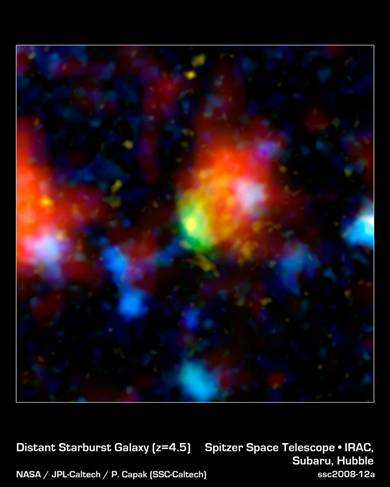14 July 2008

Astronomers have spotted an energetic stellar machine, a galaxy in the distant Universe forming stars at a surprising rate of up to 4,000 per year. For comparison, only 10 stars are born in our Milky Way Galaxy every year.
The exciting discovery was made by several telescopes, including NASA's Spitzer Space Telescope (SST). It contradicts the widely accepted theory of galaxy formation. According to the theory, known as the Hierarchical Model, galaxies slowly bulk up their stars over time by absorbing tiny pieces of galaxies, and not in one big burst as observed in the newfound "Baby Boom" galaxy.
"This galaxy is undergoing a major baby boom, producing most of its stars all at once," said Peter Capak of NASA's Spitzer Science Center at the California Institute of Technology. "If our human population was produced in a similar boom, then almost all of the people alive today would be the same age." Capak is principal author of a new report detailing the discovery in the July 10th issue of Astrophysical Journal Letters.
The Baby Boom galaxy, which belongs to a category of galaxies known as starburst galaxies, is the new record holder for the brightest starburst galaxy in the very distant Universe, with brightness being a measure of its extreme star-formation rate. It was discovered and characterized using a suite of telescopes operating at different wavelengths.
NASA's Hubble Space Telescope and Japan's Subaru Telescope, atop Mauna Kea in Hawaii, first spotted the galaxy in visible-light images, where it appeared as a feeble smudge due to its great distance.
It wasn't until SST and the Earth-based James Clerk Maxwell Telescope observed the galaxy at infrared and submillimeter wavelengths, respectively, that the galaxy stood out as a bright object. This is because it has a huge number of brilliant young stars.
When stars are born, they shine with a lot of ultraviolet light and produce a lot of dust. The dust absorbs the ultraviolet light but, like a car parking in the Sun, it heats up and re-emits radiation at infrared and submillimeter wavelengths, making the galaxy luminous to SST and the James Clerk Maxwell Telescope.
Capak and his team made followed-up observations applying a number of telescopes. They used optical data from Keck Observatory to estimate the distance to the galaxy, a staggering12.3 billion light-years. Therefore, we see the Baby Boom galaxy when the Universe was 1.3 billion years old (current cosmological theories show that the Universe is approximately 13.7 billion years old today).
"If the Universe was a human reaching retirement age, it would have been about 6 years old at the time we are seeing this galaxy," said Capak.
The astronomers made measurements at radio wavelengths with the National Science Foundation's Very Large Array in New Mexico. Together with SST and James Clerk Maxwell data, these observations enabled the astronomers to compute a star-birth rate of about 1,000 to 4,000 stars per year. At that rate, the galaxy needs only 50 million years, not very long by the standards of the cosmic time scale, to grow into a massive galaxy.
While galaxies in the nearby Universe can form stars at similarly high rates, the most distant one known previously was about 11.7 billion light-years away.
"Before now, we had only seen galaxies form stars like this in the teenaged Universe, but this galaxy is forming when the Universe was only a child," said Capak. "The question now is whether the majority of the very most massive galaxies form very early in the Universe like the Baby Boom galaxy, or whether this is an exceptional case. Answering this question will help us determine to what degree the Hierarchical Model of galaxy formation still holds true."
"The incredible star-formation activity we have observed suggests that we may be witnessing, for the first time, the formation of one of the most massive elliptical galaxies in the Universe," said co-author Nick Scoville of Caltech, the principal investigator of the Cosmic Evolution Survey, also known as Cosmos. The Cosmos program is an extensive survey of a large patch of distant galaxies across the full spectrum of light.
"The immediate identification of this galaxy with its extraordinary properties would not have been possible without the full range of observations in this survey," said Scoville.
Further Reading
SST
http://www.spitzer.caltech.edu/spitzer/
JPL
www.jpl.nasa.gov/
Aymen Mohamed Ibrahem
Senior Astronomy Specialist